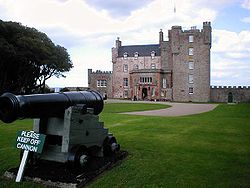
Castle of Mey
Encyclopedia

Caithness
Caithness is a registration county, lieutenancy area and historic local government area of Scotland. The name was used also for the earldom of Caithness and the Caithness constituency of the Parliament of the United Kingdom . Boundaries are not identical in all contexts, but the Caithness area is...
, on the north coast of Scotland
Scotland
Scotland is a country that is part of the United Kingdom. Occupying the northern third of the island of Great Britain, it shares a border with England to the south and is bounded by the North Sea to the east, the Atlantic Ocean to the north and west, and the North Channel and Irish Sea to the...
, about 6 miles (9.7 km) west of John o' Groats
John o' Groats
John o' Groats is a village in the Highland council area of Scotland. Part of the county of Caithness, John o' Groats is popular with tourists because it is usually regarded as the most northerly settlement of mainland Great Britain, although this is not a claim made by the inhabitants...
. In fine weather there are views from the castle north to the Orkney Islands
Orkney Islands
Orkney also known as the Orkney Islands , is an archipelago in northern Scotland, situated north of the coast of Caithness...
.
History
The lands of Mey belonged to the Bishops of CaithnessBishop of Caithness
The Bishop of Caithness was the ecclesiastical head of the Diocese of Caithness, one of Scotland's 13 medieval bishoprics. The first referenced bishop of Caithness was Aindréas, a Gael who appears in sources between 1146 and 1151 as bishop. Aindréas spent much if not all of his career outside his...
. The Castle of Mey was built between 1566 and 1572, possibly on the site of an earlier fortification, by George Sinclair, 4th Earl of Caithness
Earl of Caithness
Earl of Caithness is a title that has been created several times in the Peerage of Scotland, and has a very complex history. Its first grant, in the modern sense as to have been counted in strict lists of peerages, is now generally held to have taken place in favor of Maol Íosa V, Earl of...
. Originally a Z-plan
Z-plan castle
Z Plan is a form of castle design common in England and Scotland. The Z-plan castle has a strong central rectangular tower with smaller towers attached at diagonally opposite corners....
tower house of three storeys, it had a projecting wing at the south-east, and a square tower at the north-west. The Castle passed to George Sinclair's younger son William, founder of the Sinclairs of Mey, although it later became the seat of the Earls. The Castle's name was changed to Barrogill, and it was extended several times, in the 17th and 18th centuries, and again in 1821 when Tudor Gothic
Gothic Revival architecture
The Gothic Revival is an architectural movement that began in the 1740s in England...
style alterations were made, to designs by William Burn
William Burn
William Burn was a Scottish architect, pioneer of the Scottish Baronial style.He was born in Edinburgh, the son of architect Robert Burn, and educated at the Royal High School. After training with the architect of the British Museum, Sir Robert Smirke, he returned to Edinburgh in 1812...
. Barrogill passed out of the Sinclair family in 1889, on the death of the 15th Earl, and in 1928 it was purchased by Captain Imbert-Terry. The Castle was used as an officers' rest home during the Second World War, and in 1950 the estate farms were sold off.
Royal residence
The castle was in a semi-derelict state when, in 1952, it and its policiesEstate (house)
An estate comprises the houses and outbuildings and supporting farmland and woods that surround the gardens and grounds of a very large property, such as a country house or mansion. It is the modern term for a manor, but lacks the latter's now abolished jurisdictional authority...
(attached lands) were purchased by Queen Elizabeth The Queen Mother
Elizabeth Bowes-Lyon
Elizabeth Angela Marguerite Bowes-Lyon was the queen consort of King George VI from 1936 until her husband's death in 1952, after which she was known as Queen Elizabeth The Queen Mother, to avoid confusion with her daughter, Queen Elizabeth II...
, the widow of King George VI
George VI of the United Kingdom
George VI was King of the United Kingdom and the Dominions of the British Commonwealth from 11 December 1936 until his death...
who had died earlier in the year. The Queen Mother set about restoring the castle for use as a holiday home, removing some of the 19th-century additions, and reinstating the Castle's original name. She regularly visited it in August and October from 1955 until her death in March 2002, the last visit being in October 2001.
In July 1996 The Queen Mother made the property, the policies and the farm over to the Queen Elizabeth Castle of Mey Trust, which has opened the castle and garden to the public regularly since her death. It is now open seven days a week from 1 May until 30 September each year, with a closed period of ten days at the end of July and the beginning of August, when Their Royal Highnesses The Duke
Charles, Prince of Wales
Prince Charles, Prince of Wales is the heir apparent and eldest son of Queen Elizabeth II and Prince Philip, Duke of Edinburgh. Since 1958 his major title has been His Royal Highness The Prince of Wales. In Scotland he is additionally known as The Duke of Rothesay...
and Duchess of Rothesay usually stay at Mey. The Trust opened a new Visitors Centre in early 2007, and the visitor numbers for that year topped 29,000.

